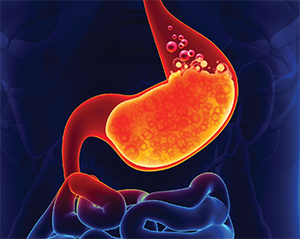SAN DIEGO—When it comes to laryngopharyngeal reflux (LPR), the standard treatment is clear: proton pump inhibitors (PPIs). But, as experts explained here at the American Academy of Otolaryngology-Head and Neck Surgery Foundation Annual Meeting, an array of options is out there, many of them non-pharmaceutical.
Explore This Issue
December 2016LPR occurs in an estimated 30% to 40% of the adult population in the United States, with a higher incidence among people who are obese, are older, smoke, suffer from high stress, and consume certain diets, said Marilene Wang, MD, professor of head and neck surgery at the University of California, Los Angeles (UCLA) School of Medicine.
Debate Over Treatment

An array of treatment options exists for LPR, many of them non-pharmaceutical.
© decade3d – anatomy online / SHUTTERSTOCK.COM
Michele Morrison, DO, FACS, a laryngologist and chair of otolaryngology-head and neck surgery at Naval Medical Center in Portsmouth, Va., said that while LPR has been accepted as a separate entity from gastroesophageal reflux, there is some lingering debate over the condition’s diagnosis and management. LPR can lead to a variety of symptoms, including chronic mucosal injury, laryngitis, and granulomas, as well as pulmonary issues such as pneumonia, and can be a trigger for head and neck cancers, including esophageal cancer and laryngeal and pharyngeal squamous cell carcinomas.
Cough, globus, dysphonia, and throat clearing are some of the ways patients present. A typical work-up includes a complete head and neck exam with flexible laryngoscopy, along with tests to obtain a reflux symptom index (RSI) score and a reflux finding score (RFS). The RSI can be helpful because patients are followed and are later retested to see how they’re doing, Dr. Morrison said. “Sometimes patients aren’t the best historians to tell you whether they’re actually better,” she said.
Objective testing options, typically performed during follow-up after patients have started treatment, include upper endoscopy, high-resolution esophageal manometry (HREM), and multi-channel intraluminal pH-impedance.
Dr. Morrison said she will typically start patients on 20 mg of a PPI twice a day, with an H2 blocker at night. At the end of treatment, PPIs should be tapered, she said, due to the risk of a rebound effect. Discussions about lifestyle changes, including not eating the day’s biggest meal at night and not eating within three hours of bedtime, are a must, she said. “I can’t emphasize enough that it’s worth those extra few minutes to really talk to the patient about their diet and their lifestyle,” she said. If patients don’t respond, the investigation should continue. “Don’t use LPR as a ‘fall-back’ diagnosis,” she said.
Voice Therapy
Voice therapy also has a role to play in correcting LPR’s effect on the voice, said Nausheen Jamal, MD, assistant professor of otolaryngology-head and neck surgery at the Lewis Katz School of Medicine at Temple University in Philadelphia. LPR can cause increased muscle tension, hard glottal attack, restricted pitch range, and abnormal shimmer and jitter, among other things. Acid suppression can help with these issues, but it doesn’t work for everyone, Dr. Jamal said (Laryngoscope. 2005;115:1230–1238).